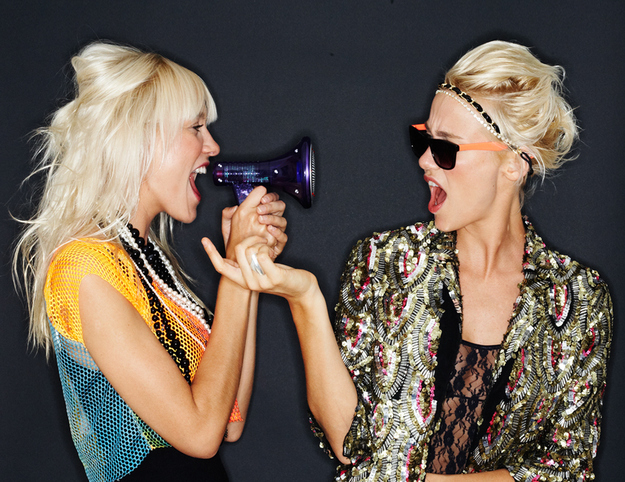
On a recent Friday night at Long Island nightclub Glo, DJs Mim and Liv Nervo are curled up on couches in the dressing room, tapping out messages on their BlackBerries and waiting to start their set. The 27-year-old Australian twin sisters — tall, leggy and blonde, with big blue eyes and wide smiles — are two of the hottest DJs in electronic dance music (EDM) at the moment; in addition to solo gigs at clubs like Las Vegas' XS and Miami's Mynt, they've also produced dance-pop hits with Afrojack, Steve Aoki and Avicii, and toured alongside Nicki Minaj and Britney Spears on the Femme Fatale Tour. And in the week following their Glo gig, the girls will play at Los Angeles' Beyond Wonderland festival and Puerta Vallarta's Electro Beach concert series, as well as three shows in Miami leading up to an appearance at the sold-out Ultra Music Festival, which kicks off tomorrow.
But the Nervo sisters' success is the exception when it comes to females in dance music. As electronic dance music EDM has moved ever more into the mainstream in recent years, it has been male DJs and producers leading the charge. Top 40 artists like Nicki Minaj, Flo-Rida and Rihanna have collaborated with DJs David Guetta and Calvin Harris on chart-topping dance-pop tracks, and dubstep DJ Skrillex received an unprecedented five Grammy nominations this year. And of the 200-plus artists performing this year at Ultra, just over a dozen are female.

Despite frequent claims of egalitarianism in EDM — electronic music has "always been an open door," says Jim Tremayne, longtime editor of DJ Times magazine — women have been largely absent behind the booth. Sara Cooper, a veteran dance music publicist who represents acts like Afrojack and Sander Van Doorn, is wary of representing female DJs. "I'll be the first to say it. I don't take girl DJs seriously," she says, "because they usually put themselves out there in a certain way." The implication, of course, is that women use their looks to get DJ gigs, whereas men rely on their mixing skills alone.
"I think it's funny how a lot of male DJs get away with just looking like geeks," says producer and DJ Laidback Luke, one of Ultra's headliners. It's a tough line for a female artist to walk: "Looks are important, since I do consider us a part of showbiz," says Luke, but he also warns against looking "over the top [or] too sexual."
As a fellow female DJ, I've encountered this point of view all too often. I have the necessary skills to spin a killer mix — the ability to read a crowd, an ear for unusual mash-ups and combinations, a 15,000-plus song iTunes library — but that’s often not enough. Like Cooper in her producing days, my DJing chops have been frequently questioned before gigs; in fact, I’ve been asked if I plan on playing a pre-mixed CD and “just standing there.” But there are few things more hilariously vindicating than watching a male clubgoer or manager’s eyes widen as I drop an unexpected track or execute a flawless mix. The Nervos evidently feel the same way: They recently retweeted a post from a male fan that reads, “WOW!!! I thought [Mim and Liv] were barbiedoll sociallites posing during a pre-mixed cd. WRONG! those girls are mad talented!”
Indeed, their DJ chops should speak for themselves, but there's no denying that Liv and Mim certainly look the part — they're every bit the bleached-blonde, beach-babe fantasy one might have of an Australian swimsuit model. For their gig at Glo, Liv wears her hair long and straight with a black fedora, while Mim's hair is short and styled in a rock-chic faux-hawk. They offset the toughness of their ripped tights and combat boots with chic, fitted tops and cropped jackets. When one sister talks, the other looks at her intently, nodding along, and they almost always finishing the sentence in unison, using their hands for animated emphasis.
They're similarly in sync behind the decks. At Glo, they stand side by side wearing matching headphones, heads bobbing simultaneously to the beat. They work together wordlessly, four hands reaching over one another to make quick changes to the mix. When a song reaches its climax, the sisters put their hands in the air at the exact same moment, pumping their fists energetically and cheering back at the euphoric crowd. Their set is full of unexpected transitions and combinations; after slowing things down with Cassius’ “I Love You So,” Liv and Mim electrify the crowd by dropping the thunderous bassline of Sandro Silva and Quinto’s “Epic.” Nervo’s own songs appear throughout the seamlessly mixed set too, at which points the girls grab a mic to sing along. They belt out the chorus of the sassy single “The Way We See The World,” as well as the lyrics of their Avicii collaboration, the dance-pop anthem “You’re Gonna Love Again.” The crowd eats it up, chanting the lyrics along with the girls — even though the latter song hasn’t yet been released.
But DJing came to them almost as an afterthought. The sisters moved to the U.K. at 19 to pursue a joint career in songwriting. To make money they worked at Nando's, the British equivalent of KFC, until a family friend suggested they model instead. "Our mom and dad had a family friend who was a photographer," says Mim. "They were like, 'Girls, rather than working at Nando's, why don't you take this guy's advice and enroll in an agency?' And we did, and we had a few jobs." Meanwhile the girls began to rack up songwriting and production credits on Japanese pop tracks, and even wrote the Hannah Montana movie theme song "Let's Get Crazy."
"We were doing music for pop stars during the week, and then going clubbing on the weekends," says Mim. Soon they realized they wanted to make music more like what they heard in Ibiza, the Spanish island known as dance music’s mecca. In characteristic Nervo fashion, Liv downplays their transition into dance-pop. "We started having some fun in the studio with big-time electronic guys," she says — which led to writing and producing three hit Armin Van Buuren singles, as well as tracks for Kylie Minogue, Ke$ha and the Pussycat Dolls. In 2009, they took on their biggest project to date: co-writing three tracks for David Guetta's album One Love, including the Kelly Rowland collaboration "When Love Takes Over." The song won two Grammy awards, and in March 2010, Astralwerks Records and Virgin Records announced they had signed Mim and Liv to a label deal that would allow them to continue writing and producing for others while also releasing their own artist tracks and developing new talent on their own Nervo Records.

"They have a great potential to become stars," says Tremayne. And whether they like it or not, Liv and Mim's pop star-friendly looks play a role in their careers. "If you're talking about anyone who aspires to David Guetta-level success," says Tremayne, "[looks] are gonna be a component to it. It happens in the worlds of rock 'n roll and pop music as well."
"We've learned the hard way," Liv says. "There are a lot of really bad photos of us out there [from DJ gigs]." As a result, she says, "modified the way we do our makeup, the way we do our hair, the clothes we wear… it is trial and error."
Just as EDM has come a long way since its disco-era roots, so too have the women trying to make it in the industry. Cooper, for instance, began her career in California's young rave scene nearly 15 years ago. She now represents some of the biggest names in EDM, but she got her start as a techno producer. "I was the first signed techno-producing girl, I was in a girl band," she says. "Anything I could do in dance music, I would do." Cooper quickly grew frustrated with the fact that her production chops were often questioned. "The majority of the questions I got [as an artist] were like, 'Who writes the music?' I didn't have a guy in the back, engineering me or doing anything." In fact, she adds, "when I did my album, my engineer was also female. It was hard to break down the barriers."

Cooper eventually stopped producing — besides, she quips, "I couldn't DJ because I couldn't beat-match for shit" — and founded a popular fan zine called The Underground. The ability to "interview everyone" for the zine got her the access she needed to sign Carl Cox as the first client of her eponymous PR firm. For the female rave DJs who stuck it out, however — women like Reid Speed and Star Eyes, who rose to fame in New York City’s 90s rave scene — life was far from glamorous. "It was dirty, and mean, and sometimes you had to sleep on people's couches, and sometimes [the parties] would get broken up," says Cooper. "And it did take a lot to be a DJ back then," she adds: not only was DJ equipment expensive, but it was heavy too. Carrying a pair of turntables, a mixer, and crates of records presented an actual physical barrier for female DJs.
In 2012, it's easier than ever to experiment with DJing and producing: mixers have been replaced with laptops, crates of records with portable hard drives, and elaborate studio setups with a few simple apps. "The reason is obvious," says Tremayne. "Technology is different now, and you don't have to shlep around as much equipment." Yet, he says, "we've done surveys of our [DJ Times] readership, and it's 90 percent guys."
Ultimately, of course, the Nervo sisters' skills behind the booth will determine their longevity in the industry. "If they were like the Sarah Palins of house music, with no talent," says Tremayne, "then people would see through it. But I believe they have the goods."

